We’re going a tad out of order here – Chris’ magna opus on South Indian cuisine is forthcoming but until then, here is an entry regarding our last day in India. More on our Grand Asian Voyage to come!
On our previous trips to India, Chris and I were fortunate to be traveling with Vassar in his case, and in mine, for my previous employer, a luxury travel company. One crucial element was provided for both of us – logistics. Thus we were able to enjoy the wonders of the Subcontinent without fretting about where we were going to have dinner or being endlessly hounded by touts. How I pitied the dreadlocked, didgeridoo toting backpackers I saw getting off buses in rural locales, greeted not by signs with their names but a swarm of unrelenting drivers or knick-knack sellers.
DIY India is a much different matter. The chances of having a pleasant day are much slimmer when you have to fend for yourself on every account – will the taxi driver drop us off in the fun part of Chor Bazaar, or will he drop us off in dead lawnmower /trash-eating goat alley? And should we just be thankful that we’re in mower/goat alley at all, because he could easily not speak English and/or know where he’s going? But these types of experiences, while stressful, have made us better travelers and hopefully more patient people. They are what we will look back on in years to come as the moments that defined our Grand Voyage.
India, like New York, is best observed on a sliding scale – the glimmers of goodness equal or outweigh the mountain of hassles that, on bad days, can break you. On our last day in India, we decided to spend the morning having coffee from down the street, carefully mapping out each location we wanted to go to and calling them to make sure they were open. In this way, we hoped to minimize unpleasant surprises, and be properly caffeinated if the time came for a head-waggling showdown. Jai ho! The places we went to are all walkable from each other, meaning the only taxi rides you’ll have to take are to Kala Ghoda and back if you are staying far from there. Kala Ghoda means black horse; the banner above is a local landmark and perhaps a stand-in for the original Kala Ghoda, the statue of King Edward VII mounted on a horse that is now displayed in the Bhau Daji Lad Museum in central Mumbai.
Our first stop was an early lunch at Trishna for what a local friend describes as “glorious seafood.” I had been here once before but this visit had me singing Hallelujah after every soul-restorative mouthful of Hyderbadi pomfret and lentils. While Mumbai was the most aggravating place we went to, the food was definitely the best we’d had in all of India. I can still taste the crunch of caramelized black peppercorns on the fish matched by the delicate, silky flesh below. We didn’t make a reservation since we got there early; the business lunch crowd arrived around 12:30pm. I’d definitely make reservations for dinner.
Trishna
Birla Mansion, Sai Baba Marg (next to Commerce House)
Kala Ghoda, Fort
Tel: 022/2270-3213; 022/2270-3214, 022/2270-3215
After lunch, we stopped in FabIndia, a must on any shopaholic’s trip to India. It’s a wonderful place to pick up gifts and housewares that you will be complimented on for years to come. Yes, it’s in every guidebook and you can probably get better deals at flea markets, but that brings up the whole hassle issue, which we wanted to avoid. The multi-story location in Kala Ghoda was the largest FabIndia we visited, but selection still varies from store to store. This one definitely had the most clothing and accessories but we saw more furniture at a store in Bangalore. Even if you’re not interested in buying, stopping in can be a welcome sanity break.
FabIndia
Jeroo Building,
137, M.G. Road, Kala Ghoda, Colaba,
Mumbai – 400001
Ph: +91-22-22626539, 40
Email: jeroo.bombay@fabindia.net
Hours: 10:00 am to 8:00 pm daily
After checking a few more people off our Christmas lists, we felt emboldened and sought out Britannia Café, a Parsi café mentioned in TimeOut Mumbai. Unfortunately it turned out to be a total dump; we didn’t even want to walk in. It is incredible how so many travel guides romanticize places – CNNGo calls it “a crumbling testament to Mumbai’s once-thriving Parsi café culture” by way of recommendation – that are completely unpalatable in person. If the choice is between eating no Parsi food or having it in dilapidated environs, I choose the former. It is located in a business district called Ballard Estate so I suppose most of their clientele are office workers or loyal customers.
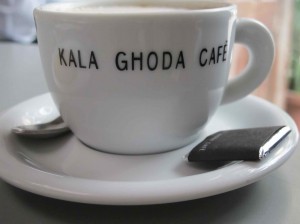 We retreated to Kala Ghoda Café, which is located across the way from Trishna, for coffee and a refreshing glass of mint lemonade. For such a small place (there are probably 15 seats) the menu is surprisingly large with salads, snacks, sandwiches and desserts served from lunch onwards. There is a separate breakfast menu. It took awhile for our beverages to come out, though, so if you’re going for food, I imagine there would be an even longer wait. The ginger ice cream is wonderful and locally made; cookies should be given a miss. Most of the non-Indian coffee sold at Starbucks knock-offs is very expensive and not great but Kala Ghoda’s java, with an authentic cap of milk foam, is worth it.
We retreated to Kala Ghoda Café, which is located across the way from Trishna, for coffee and a refreshing glass of mint lemonade. For such a small place (there are probably 15 seats) the menu is surprisingly large with salads, snacks, sandwiches and desserts served from lunch onwards. There is a separate breakfast menu. It took awhile for our beverages to come out, though, so if you’re going for food, I imagine there would be an even longer wait. The ginger ice cream is wonderful and locally made; cookies should be given a miss. Most of the non-Indian coffee sold at Starbucks knock-offs is very expensive and not great but Kala Ghoda’s java, with an authentic cap of milk foam, is worth it.
Kala Ghoda Café
10 Ropewalk Lane
Kala Ghoda
Fort
Mumbai 400 001
Phone +91 22 2263 3866; +91 98 3380 3418
Email info@kgcafe.in
Hours: 0900 to 2345
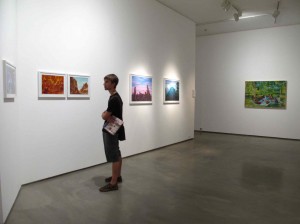 We wandered back up MG Road and spent about an hour in Gallery BMB. At the time, they had hung a show on diaspora artists, which was a fantastic primer into the world of contemporary Indian art in a variety of media. The gallery is big enough such that even if you have only a passing interest in art, it would take a minimum of 15 minutes to see everything, which is more than I can say about a lot of other commercial galleries anywhere. There is also a nice library/shop/café there to rest and ruminate on what you just saw. We didn’t have time for Chemould Prescott Road Gallery, another well-regarded space located just upstairs from BMB, as we were rushing to a documentary.
We wandered back up MG Road and spent about an hour in Gallery BMB. At the time, they had hung a show on diaspora artists, which was a fantastic primer into the world of contemporary Indian art in a variety of media. The gallery is big enough such that even if you have only a passing interest in art, it would take a minimum of 15 minutes to see everything, which is more than I can say about a lot of other commercial galleries anywhere. There is also a nice library/shop/café there to rest and ruminate on what you just saw. We didn’t have time for Chemould Prescott Road Gallery, another well-regarded space located just upstairs from BMB, as we were rushing to a documentary.
Gallery BMB
Queens Mansion | Ground Floor
Next to Cathedral (Middle) School
G. Talwatkar Marg
Fort | Mumbai 400 001
p – +91 22 6171 5757
email: info@gallerybmb.com
www.gallerybmb.com
Mon-Sat, 11-7pm
Chemould Prescott Road Contemporary Art Gallery
Chemould Prescott Road
Queens Mansion | 3rd Floor
G. Talwatkar Marg
Fort | Mumbai 400 001
t : +91- 22- 22000211 / 2
f : +91- 22- 22000213
e : art@gallerychemould.com | gallerychemould@gmail.com
Mon-Sat, 11-7pm
The one thing TimeOut Mumbai was right about was the fact that Max Mueller Bhavan, the local Goethe Institut chapter, shows films. And being Germans or people who work for them at least, whomever updates the website uploaded a calendar of events for the current month – amazing!
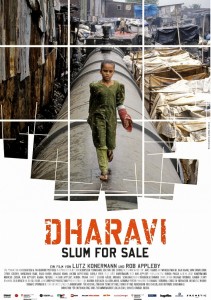 We saw a documentary called Dharavi, Slum for Sale, directed by German Lutz Konermann. Dharavi focuses on a variety of characters: a developer named Mukesh Mehta who has a plan to re-develop Dharavi, which just happens to be on prime real estate; Rais Khan, a widowed tailor and slum dweller who cannot make ends meet for himself and his two children; Soni Shrivastavas, a resident of Dharavi who had to drop out of school as her family could not afford tuition for her and her siblings; and others related to the slum, from political candidates to lobbyists. The place was packed and people sat on the floor and in the aisles. The scene I found most affecting was one where Soni was helping her sisters get ready for school – off they went in their plaid uniforms, with their hair neatly plaited and stiff rectangular backpacks. How many did I pass daily, not knowing that they slept in a makeshift hut with a corrugated iron roof?
We saw a documentary called Dharavi, Slum for Sale, directed by German Lutz Konermann. Dharavi focuses on a variety of characters: a developer named Mukesh Mehta who has a plan to re-develop Dharavi, which just happens to be on prime real estate; Rais Khan, a widowed tailor and slum dweller who cannot make ends meet for himself and his two children; Soni Shrivastavas, a resident of Dharavi who had to drop out of school as her family could not afford tuition for her and her siblings; and others related to the slum, from political candidates to lobbyists. The place was packed and people sat on the floor and in the aisles. The scene I found most affecting was one where Soni was helping her sisters get ready for school – off they went in their plaid uniforms, with their hair neatly plaited and stiff rectangular backpacks. How many did I pass daily, not knowing that they slept in a makeshift hut with a corrugated iron roof?
During the Q&A after the screening with Konermann and Bhau Korde, a well-respected, long-term resident of Dharavi, there was some tension in the room as a group of Indian film students was clearly rubbed the wrong way by the fact that a foreigner made a film about a hot-button topic on their home turf. “There are a lot of movies made about Dharavi, and yours says nothing new,” said one clad in a Gucci-logoed baseball cap. I can understand the feeling of being undermined in one’s own home, of feeling misrepresented somehow. But the fact that this documentary exists, I think, is a healthy by-product of our world order. First world countries have the means to fund filmmakers in making documentaries about the third world that receive international distribution as a result. There are many causes that would go unknown were it not for the existence of grant-giving foundations headquartered far from Dharavi’s sea of blue tarpulin roofs – ironic that Brahmins’ homes were once painted the same hue to signify the gentry within. While it is true that there are numerous documentary efforts about Dharavi, both for film and television, clearly the slum is home to stories that need to be told. Even after reels of footage have been shot and cut, an actual solution for giving slum dwellers the resources they need to survive and thrive remains lacking. “Why not let Dharavi develop as it is?” asked Konermann. A question that still has no answer.
Max Mueller Bhavan
K Dubash Marg
Mumbai, Maharashtra 400001, India
Tel.: +91 22 22027710
Fax: +91 22 22873826
info@mumbai.goethe.org
After our minds were fed, it was once again time for our stomachs. We had tried some street eats at the highly touted Swati Snacks a few days earlier and upon our friend Rajeev’s recommendation, we went to Elco Arcade for another helping of the dishes we shied away from sampling on sidewalks. The taxi driver asked for directions twice and I presume the second direction-giver he asked was so exasperated with explaining something simple that he got into our taxi and rode with us to Elco, which was just a few blocks away. When we got out, he did as well, and said we made a good choice for dinner. Hurrah!
Once there, we ordered Bhel Puri, Pani Puri, Tava Aloo Chaat and Dahi Aloo Chaat. We were flying in the dark somewhat, but Bhel Puri is to our knowledge the most common of Mumbai’s street foods so we had to order that to compare it with Swati’s. With its combination of puffed rice, crunchy, diced vegetables and tangy sauce, Bhel Puri is like jumper cables to a weary palate – should you be suffering in a place with bland food, it should be Bhel Puri to the rescue! Pani Puri provides the same effect with different ingredients: fried mini puffs of unleavened bread (puri), sprouted beans and nuggets of curd that you can pile onto a spoon and dip into the sauces provided. The pistachio kulfi was a little disappointing but otherwise the day was absolutely perfect. As we packed our bags, we smiled at the unexpected feeling of wishing we didn’t have to leave for Nepal.
Elco Arcade
Ramdas Nayak Road,
Santosh Nagar, Bandra West
Mumbai, Maharashtra, India

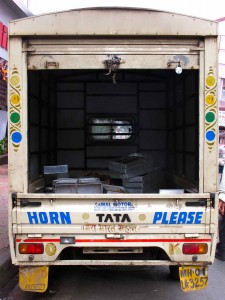
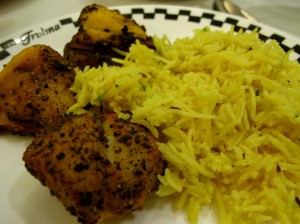
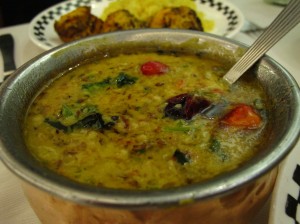
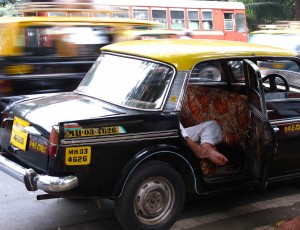
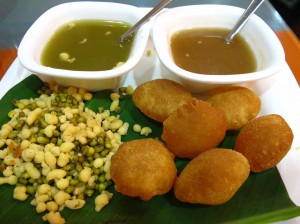
I’m following your journey, inner and outer, with great anticipation. Don’t know if I mentioned (probably): I was in Peace Corps Nepal. India was close to hand. But that was young man’s country.